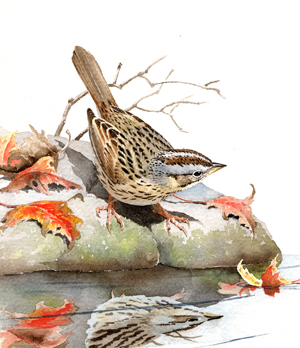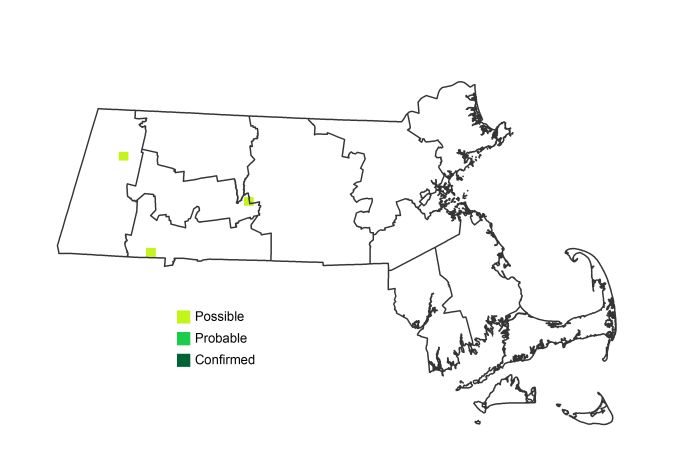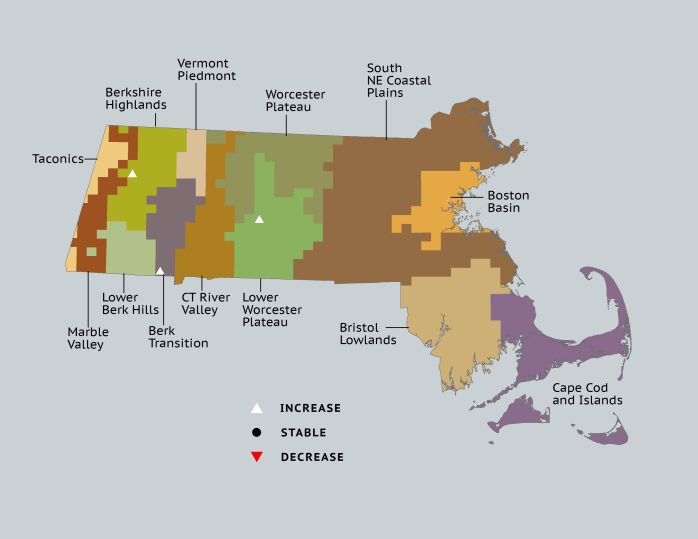Find a Bird
Lincoln's Sparrow
Melospiza lincolnii

Very local, trend not established
“Avoid popularity if you would have peace.” – Abraham Lincoln
Though fairly regular during fall migration, the Lincoln’s Sparrow is rarely encountered in Massachusetts during the summer. Breeding Lincoln’s Sparrows are seldom seen, typically keeping themselves concealed in the underbrush in willow thickets and boreal bogs until it is time to fly south once again. Massachusetts is at the very southern edge of their breeding distribution and Lincoln’s Sparrows are particularly difficult to find, but their continued summer presence and a small number of past confirmations suggest that at least some breeding activity may regularly occur.
Historic Status
Most nineteenth-century accounts of the birds of Massachusetts quickly gloss over the Lincoln’s Sparrow, or Lincoln’s Finch, often noting its rarity. “What has a bird, as inconspicuous as Lincoln’s Sparrow, done, that it must hide itself so assiduously from human eyes?” asked Edward Howe Forbush (Forbush 1929). Although identified by Audubon a century earlier in Labrador, it did not make the earliest Massachusetts lists, perhaps because of its propensity to skulk. It maintained its near invisibility through the first half of the twentieth century, remaining a marginal migrant and a rare sighting for lucky birders here or there.
Atlas 1 Distribution
Lincoln’s Sparrow evaded Confirmation – or even detection – throughout the period of Atlas 1. That the species was known to breed in nearby Vermont and New York, and had furthermore been detected in Massachusetts during previous breeding seasons, was insufficient evidence to add the bird definitively to the list of breeding species in the Bay State. The discovery of a Lincoln’s Sparrow nest in Florida, Massachusetts, in 1981 marked the first and, to date, the only Confirmed record of this species breeding in the Commonwealth, although the species apparently did not fully embrace the concept of summering in Florida.
Atlas 2 Distribution and Change
In Atlas 2 Lincoln’s Sparrows were found in 3 blocks during the species' Safe Dates, one each in the Lower Worcester Plateau, the Berkshire Transition Zone, and the Berkshire Highlands. They were only coded as Possible in all 3 blocks, meaning that they were only seen once in Safe Dates, and in breeding habitat.
Atlas 1 Map

Atlas 2 Map

Atlas Change Map

Ecoregion Data
Atlas 1 | Atlas 2 | Change | ||||||
Ecoregion | # Blocks | % Blocks | % of Range | # Blocks | % Blocks | % of Range | Change in # Blocks | Change in % Blocks |
Taconic Mountains | 0 | 0.0 | 0.0 | 0 | 0.0 | 0.0 | 0 | 0.0 |
Marble Valleys/Housatonic Valley | 0 | 0.0 | 0.0 | 0 | 0.0 | 0.0 | 0 | 0.0 |
Berkshire Highlands | 0 | 0.0 | 0.0 | 1 | 1.8 | 33.3 | 1 | 1.9 |
Lower Berkshire Hills | 0 | 0.0 | 0.0 | 0 | 0.0 | 0.0 | 0 | 0.0 |
Vermont Piedmont | 0 | 0.0 | 0.0 | 0 | 0.0 | 0.0 | 0 | 0.0 |
Berkshire Transition | 0 | 0.0 | 0.0 | 1 | 2.5 | 33.3 | 1 | 3.2 |
Connecticut River Valley | 0 | 0.0 | 0.0 | 0 | 0.0 | 0.0 | 0 | 0.0 |
Worcester Plateau | 0 | 0.0 | 0.0 | 0 | 0.0 | 0.0 | 0 | 0.0 |
Lower Worcester Plateau | 0 | 0.0 | 0.0 | 1 | 1.3 | 33.3 | 1 | 1.9 |
S. New England Coastal Plains and Hills | 0 | 0.0 | 0.0 | 0 | 0.0 | 0.0 | 0 | 0.0 |
Boston Basin | 0 | 0.0 | 0.0 | 0 | 0.0 | 0.0 | 0 | 0.0 |
Bristol and Narragansett Lowlands | 0 | 0.0 | 0.0 | 0 | 0.0 | 0.0 | 0 | 0.0 |
Cape Cod and Islands | 0 | 0.0 | 0.0 | 0 | 0.0 | 0.0 | 0 | 0.0 |
Statewide Total | 0 | 0.0 | 0.0 | 3 | 0.3 | 100.0 | 3 | 0.4 |



